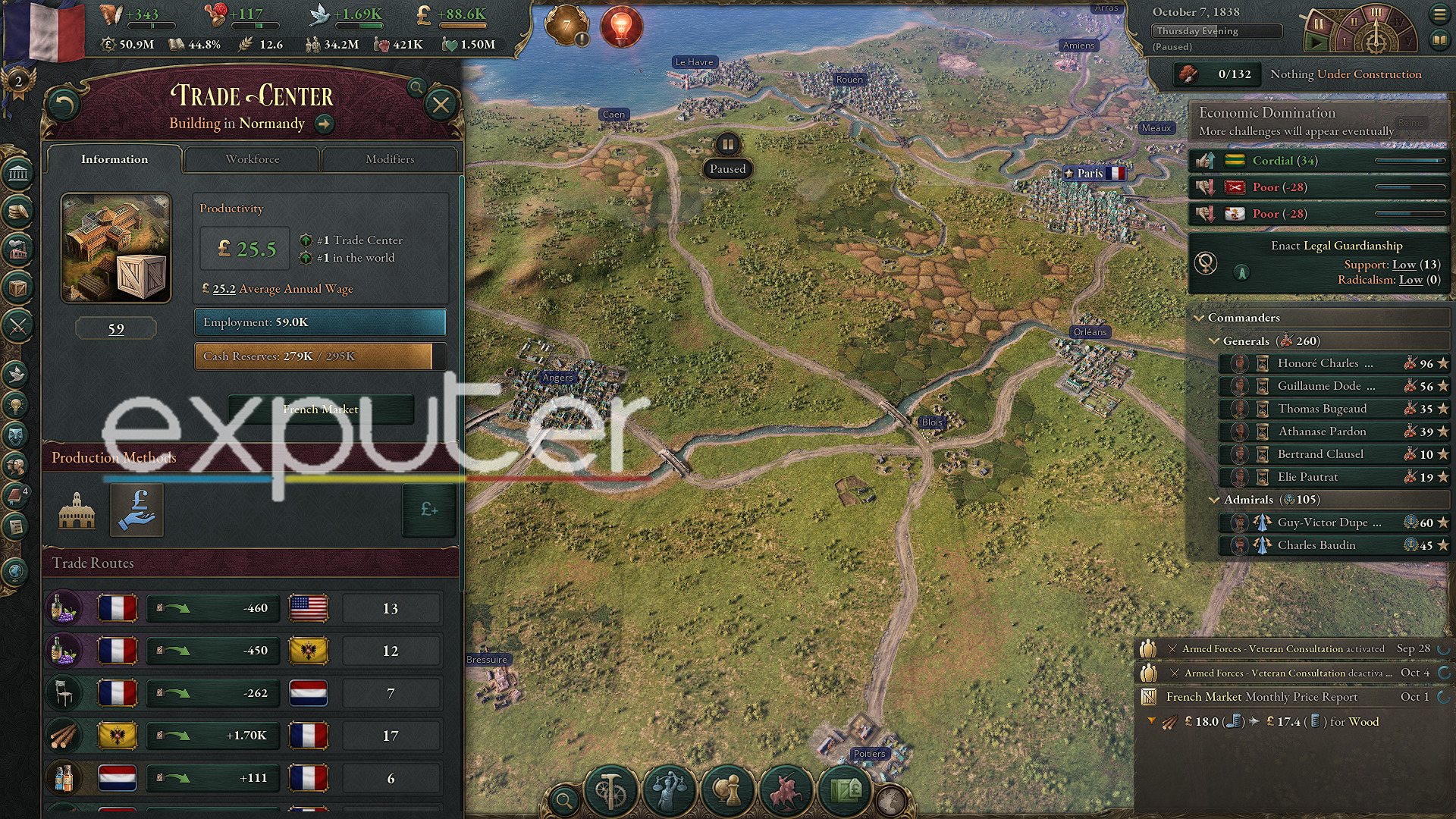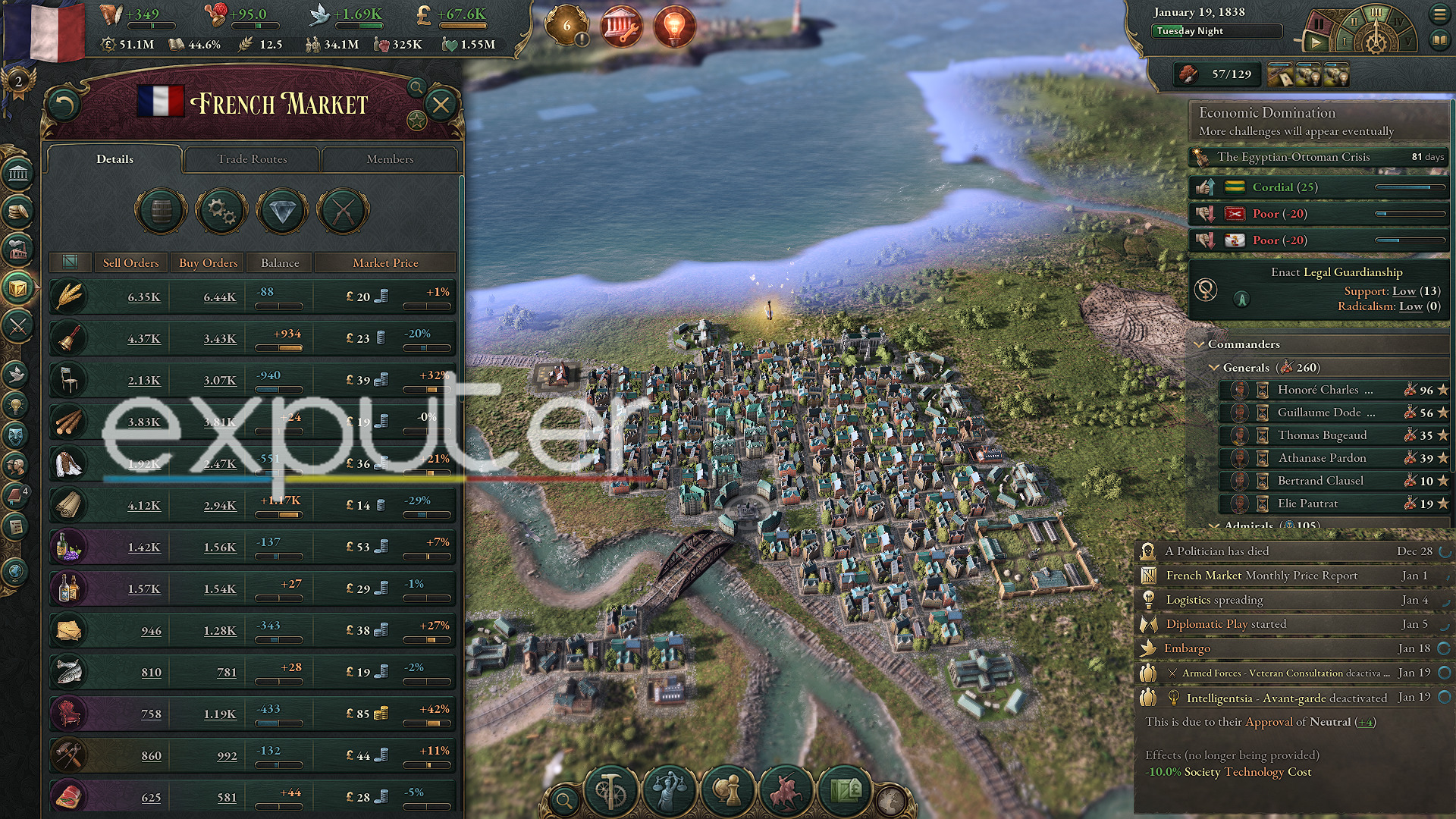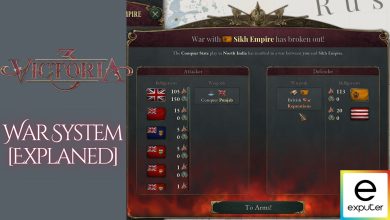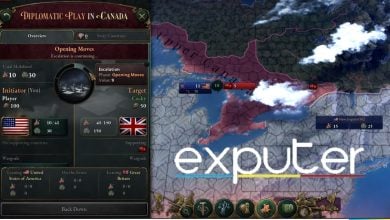There are certain requirements in Victoria 3 that make you eligible for a trade center. The trade center then allows you to interact with other countries so you can make the supply and demand model more efficient.
- Trade centers in Victoria 3 function like urban centers, monitoring international markets and routes.
- They display tariffs, employment, and the flow of imported and exported goods.
- Establishing a trade center requires sound market policies, tariff policies, robust production, and effective trade routes (convoys for sea trade).
- Building a trade center necessitates a well-established trade route and aligned international trading policies.
- Bureaucracy impacts international trade, with negative effects leading to high taxes and reduced profitability.
- Trade routes can be land or sea-based, the latter requiring convoys.
- The game’s market and trade routes section provides detailed statistics on current imports and exports, potential trade goods, and the impact on employment.
What Is Trade Center In Victoria 3

They play a pivotal role in international transactions, impacting urbanization. Recognizing alliances, rivalries, and complex diplomatic relationships is vital. Trade decisions can trigger chain reactions; for instance, relying on an ally of your rival for supplies may lead to complications during conflicts. Strategic trade choices significantly influence diplomatic relations and resource access.
Building A Trade Center
As mentioned earlier, you cannot build a trade center like other buildings, rather it comes out on its own. However, you need to fulfill a list of things if you want to see it in your nation. It requires good market policies, tariff policies, good production, trade routes, and convoys if you are planning on using the sea.
Trade Routes

- Crafting a trade route demands careful consideration. Evaluate profit margins and surplus production before initiating a trade route.
- Choose between land and ocean routes based on geopolitical factors. For landlocked nations, land routes are the sole option, while ocean access necessitates convoys.
- Navigate the market and trade route statistics for comprehensive insights.
- Assess current imports, exports, tariffs, and the impact on employees.
- The market provides a detailed list of potential goods for import/export, highlighting opportunities for profit based on price differentials.
- Use the New Import/Export Route options for flexibility in adjusting routes, countries, and goods.
Tariffs And Market Policies

Market goods policies, like “Protect Domestic Supply” and “Encourage Export,” allow nations to control imports, exports, and tariff-related revenue. Understanding these choices is crucial, especially under Protectionism or Mercantilism, as they impact market goods policies.
Protectionism
If you choose the Protectionism trade policy law with no priority, then it will have a 10% tariff on both the imports and the exports. Therefore, by default, your nation will not have a preference towards either one. However, if you have the protect domestic supply with protectionism, there will be a 0% tariff on imports and a 20% tariff on exports. It will prevent your nation from exporting goods, and there will be higher imports.
- On the other hand, protectionism with encouraging exports will have a 20% tariff on imports and a 0% tariff on exports.
- Here, you will see an increase in exports but a drastic decrease in imports due to a much higher tariff rate.
Mercantilism
Apart from Protectionism, you can go for Mercantilism. Here, on default, there will be a 5% tariff on exports and a 15% tariff on imports. Therefore, by default, your nation will have more exports and fewer imports. By choosing the protect domestic supply, there will be a 0% tariff on imports and a 10% tariff on exports. However, by choosing the encouraged exports, there will be a huge 30% tariff on imports and a 0% tariff on exports.
National Market

- On the other hand, if a product has less supply may be due to season or other conditions but higher demand, then the product will have an increase in price.
- Therefore, to keep the prices in balance, you will need to make sure that the supply side remains optimal.
Types Of Goods

- Industrial goods, like coal and glass, depend on a nation’s industrialization level.
- Luxury goods, including wine and porcelain, are in demand with improved living standards.
- Military goods, like artillery, are needed during wars, influencing demand.
Understanding these categories is essential for effective economic management in the game.
Trade Center’s Purpose And Benefits
Now that you meet all the requirements and have a basic understanding of them, it is time to know the purpose of a trade center. The trade center is interconnected with many things in Victoria 3. It allows you to increase urbanization, the standard of living, employment, and much more.
Dealing With Supply And Demand
However, the main purpose of building up a trade center is to overcome shortages and deal effectively with surpluses. There are certain goods that are not available so easily in a nation on its own. You can have a huge nation with only a small agricultural land. When that happens, your population will demand more than what is being supplied.
- If you don’t have a trade center, then the prices will increase drastically during the shortage season.
- With that, more and more people will have trouble getting staple goods.
- Due to this, you might begin to see an increase in radicals.
- To keep the loyalists’ number high, you can simply go overseas to meet their demands.
Transportation Of Goods
The placement of the Trade Center is strategic and typically aligns with the proximity to your primary trade route. For sea channels it will be established in the nearest city, optimizing both speed and cost-effectiveness. In the case of a landlocked country, the Trade Center is strategically positioned near the border, connecting multiple nations, enhancing efficiency, and minimizing transportation expenses.
- For nations with access to the sea, acquiring convoys becomes essential.
- Produced by ports, convoys gauge your nation’s capacity to supply goods through established trade routes.
- Maintaining an ample number of convoys, exceeding the required count, ensures a smooth and uninterrupted flow of goods, preventing shortages or delays in transportation.
Decreasing Unemployment
The industrialization age brings forth a surplus of willing workers. In times of high unemployment, the trade center emerges as a significant source of employment. The bustling activity in the trade center facilitates considerable job opportunities. The world’s top trade center can accommodate a substantial workforce, reaching up to 59,000 employees.
- Within the trade center, clerks constitute a significant portion of the workforce, alongside capitalists.
- Clerks receive an average annual wage of £14.4, while capitalists earn an average annual wage of £57.6.
- Consequently, the trade center not only addresses unemployment concerns but also contributes to an enhanced standard of living.
Increasing Migration Attraction
Apart from increasing employment, the trade center will also increase migration attraction by up to 25%. Not only will it increase productivity but also the taxes and other sources of revenue. Lastly, if your trade center is in the mature stages, you can have a drastic effect on urbanization. So much so that you can be expecting up to an increase of more than 300.
Final Words
All in all, the trade center is the key to advancing your economy in Victoria 3. You will be able to increase employment, tariffs, taxes, migration attraction, and a lot more. The population will reap its benefits the most as they will be able to buy goods at a reasonable price. Moreover, make sure that your ties with other countries are good otherwise, it will affect your trade routes a lot.
Up Next:
Thanks! Do share your feedback with us. ⚡
How can we make this post better? Your help would be appreciated. ✍



